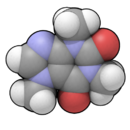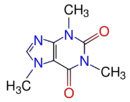Caffeine
| Caffeine | |
|---|---|
 
| |
| General | |
| Systematic name | 1,3,7-trimethyl-1H-purine- 2,6(3H,7H)-dione |
| Other names |
Coffeine, theine, mateine, |
| Molecular formula | C8H10N4O2 |
| SMILES | C[n]1cnc2N(C)C(=O)N(C)C(=O)c12 |
| Molar mass | Molar mass::194.2 g/mol |
| Appearance | When pure, a oderless white powder. |
| CAS number | CAS number::58-08-2 |
| Properties | |
| Density and phase | [[Density::1.2 g/cm3]], Solid |
| Solubility in water |
22 mg•mL−1 (25 °C) |
| Melting point | Melting point::237°C |
| Boiling point | Boiling point::178°C |
| Basicity (pKb) | 0.8 |
| Hazards | |
| MSDS | MSDS Data |
| Main hazards | May be fatal if inhaled, swallowed
or absorbed through the skin |
| Flash point | N/A |
| R/S statement | R: 22 S: ? |
| RTECS number | EV6495400 |
Caffeine is a central nervous system stimulant and the most popular drug in the world. It is produced from leaves and seeds of different kinds of plants and can also be synthesized artificially. Its effects include increased alertness, energy, and a general sense of good mood. Caffeine can be found in coffee, tea, chocolate, pain relievers, and soft drinks. In solid form, caffeine is white crystalline substance that tastes very bitter.[1]
Properties
Caffeine is perhaps the most popular drug in the world. The color of it is white and it taste bitter. The form of it is crystalline substance. People isolated caffeine from coffee in 1820. Name of coffee and caffeine comes from Arabic word qahweh. The amount of caffeine in coffee differs by kinds of coffee. If beans come from arabica, it has 1.1% of caffeine. If bean comes from robusta, it has about 2.2% of caffeine. Caffeine also can be found in cacao and chocolate products. People also isolated caffeine from tea in 1827. When people found it, they named it as "theine" because people thought it was different from caffeine in coffee. Tea has about 3.3% of caffeine. [2]
History
People began consuming caffeine as far back as the Stone Age. People discovered that bark, leaves, and seeds of several plants help people to reduce anxiety. It was found that caffeine's effects become better when caffeine is dropped into hot water.[3]. In 1821, people extracted caffeine from coffee. People first discovered coffee in Ethiopia. After that, people introduced it too Arabia and other regions. When Ethiopians found coffee, they actually found it from their animals. People thought that since animals eat the fruits, energy comes from fruits. They decided to try the seeds and that helped people to gain energy. [4] A goatherder named Kaldi discovered that his goats did not got to sleep for long time after his goats consumed coffee plants.[3] People introduce coffee to Europe in 1573. In 1657, people started to like tea and it became very popular among Europeans. Later, people discovered many cola products and it became most popular among caffeine drinks.[4]
Occurrences

People can easily find caffeine from different kinds of plant. Caffeine usually act like a natural pesticide. Caffeine can kill the insects on the plant. People also find a lot of caffeine in soil o coffee bean seedlings. Thus, it is concluded that caffeine works as natural pesticide and help of seed germination. Even though people concluded that, caffeine is most commonly used for tea and coffee. There are less caffeine in guarana plants and yerba mate which are needed to make energy drinks and teas. Caffeine can be called as two different names and they are from those two plants. Coffee plant, also known as coffee bean, is the world's primary sources of caffeine. Amount of caffeine differs depending on coffee's types and preparations. Usually, dark roast coffee has less caffeine because dark roast coffee takes long time to be roasted. If roasting time is long, amount of caffeine is reduced. Caffeine is also used for tea. Even though there more caffeine in tea than coffee, tea is brewed weaker. Just like coffee, amount of caffeine in tea depends on the process of brewing. Caffeine also can be used as ingredients for cola. Soft drinks usually have 10-50 milligrams of caffeine. However, energy drinks contain more caffeine. Chocolate is the one who contains less amount of caffeine. Recently, many people started to put caffeine into shower products. They assert that it is good for skin to absorb caffeine. However, there is not official prove for those asserts. Some people say that it will bring harmful effect to skin. [5]
How caffeine works
Caffeine alters the chemistry of the brain, and in particular the actions of adenosine that is connected with sleep. When adenosine binds to adenosine receptors in the brain, it slows down nerve cell activity, causing one to feel drowsy. Binding also causes blood vessels in the brain to dilate, presumably to let in more oxygen uptake during sleep. Nerve cell can not distinguish caffeine from adenosine. Thus, when caffeine bind to the adenosine receptors, the normal reduction in cell activity is prevented. When caffeine takes all the receptors, cells cannot bind adenosine. Instead of slowing down, it speeds up cellular activity. Caffeine also constricts brain's blood vessels by preventing adenosine's ability to cause dilation. This is why some headache medicines contain caffeine. [6]
Decaffeination
Decaffeination is an important process in order to extract caffeine from coffee to make decaffeinated coffee. Caffeine can be extracted by water extraction, supercritical carbon dioxide extraction, and extraction by organic solvents.
Water extraction
People first put coffee beans into water. After that, water will go through activated charcoal that removes the caffeine. People can put water back after caffeine is extracted. Decaffeinated coffee will have good smell. Coffee makers reuse caffeine and resell it for soft drinks.
Supercritical carbon dioxide extraction
Supercritical carbon dioxide is solvent for caffeine. For the extraction, CO2 is mixed with the green coffee beans at 31.1 °C . It will dissolve 97- 99% of caffeine. [7]
Effects on Health
If one takes too much of caffeine, it can lead one to have certain conditions. This is called as caffeinism. Caffeinism is a combination of physical and mental disorders. It causes people to have anxiety, irritability, nervousness, insomnia, headaches, and tremulousness. [8]
Caffeine intoxication
If one takes over 300 milligrams of caffeine, one can have disorders of central nervous system called caffeine intoxication. Symptoms of caffeine intoxication can be excitement, nervousness, restlessness, insomnia, increase urination, muscle twitching, rambling flow of thought and speech, irritability, irregular hear beat, and flushing of the face. If one takes too much of caffeine, he or she can die.[9]
Caffeine Anxiety and sleep disorders
The American Psychological Association (APA) usually diagnose two different types of disorders from caffeine. One is caffeine- induced sleep disorder and other one is caffeine- induced anxiety disorder. Both of disorders can be resulted from taking too much of caffeine.[10]
Caffeine Effects on memory and learning
Many people who study about caffeine asserted that caffeine cause disorders in memory and learning too. A research showed that caffeine consumption slowed hippocampus - dependent learning and damaged long- term memory in mice. Consuming caffeine 4 weeks also reduced hippocampal neurogenesis.[11]
Caffeine intake during pregnancy
Even though researches view caffeine as safe substance, some study asserted that pregnant women can have miscarriage if she consumes more than 200 milligrams per day. However, some people believe that there are no relations between caffeine and miscarriage. Since there is no right answer, pregnant women should be careful with consuming caffeine. They should limit their caffeine about 200 milligrams per day. [12]
Interesting Facts
- Caffeine is world's most popular drug.
- Caffeine stimulates nervous system.
- People can die by over consuming caffeine.
- Caffeine addiction usually start in three days.
- Caffeine can be found in over 60 plants,
- About 80% of adults consume caffeine.
- The average amount of caffeine that adults take is 280 mg.[13]
Amount of caffeine
| Name of Products | Amount of Products | Amount of Caffeine |
|---|---|---|
| Monster energy drink | 8 oz. | 83 mg |
| Rockstar energy drink | 8 oz. | 80 mg |
| Mountain Dew | 12 oz. | 55 mg |
| Coca-Cola | 12 oz. | 54 mg |
| Iced tea | 12 oz. | 70 mg |
| Cocoa beverage | 5 oz. | 4 mg |
| Dark chocolate | 1 oz. | 20 mg |
| Diet Coke | 12 oz. | 45 mg |
| Brewed Coffee(Drip Method) | 5 oz. | 115 mg |
Video
References
- ↑ What is caffeine Taj pharmaceuticals
- ↑ Facts about:caffeine 4david
- ↑ 3.0 3.1 History of Caffeine Taj pharmaceuticals
- ↑ 4.0 4.1 History of Caffeine The Caffeine Page
- ↑ occurrence of caffeine Taj pharmaceuticals
- ↑ how caffeine works fit & health
- ↑ Decaffeination of caffeine Taj pharmaceuticals
- ↑ overuse of caffeine Taj pharmaceuticals
- ↑ caffeine intoxication Taj pharmaceuticals
- ↑ sleep disorders Taj pharmaceuticals
- ↑ bad effects of caffeine Taj pharmaceuticals
- ↑ caffeine effects during pregnancy Taj pharmaceuticals
- ↑ interesting facts of caffeine over caffeinated
- ↑ Products that contain caffeine TeensHealth
- ↑ How caffeine works HowStuffWorks, youtube.com, 9 March. 2007.
External Links
- Additional information about caffeine Betty Kovacs, MS, RD, Medicine.Net
- Questions and answers about caffeine Coffee and Caffeine FAQ
- Side effects of caffeine Drugs.com
| ||||||||||||||


